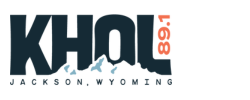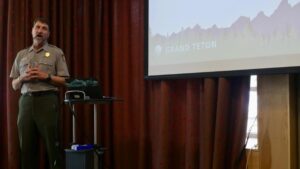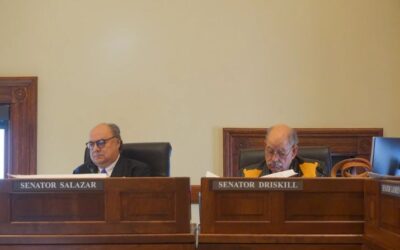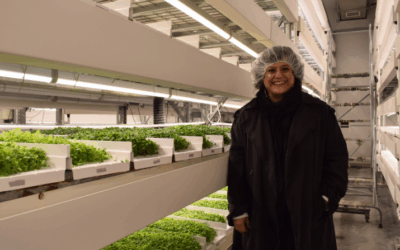Grand Teton National Park hosted a public meeting at the Teton County Library in Jackson on July 16 to hear from folks about their hopes for the park for the next couple decades. The agency is looking for input on what it’s referring to as “desired conditions,” which is essentially how park staff should manage different parts of the park moving forward.
During the meeting, Superintendent Chip Jenkins kicked off a series of presentations about the history of visitor management and how visitors are interacting with Grand Teton National Park today.
“One of the things that we really want you and other people to take away from this is that the National Park Service, together with the local community, has been actively managing visitation since the creation of the park,” he said.
Jenkins went on to detail how the park’s first master plan in the 1940s resulted in the road that now winds along the base of the Tetons. Federal investments in the 1950s and 1960s helped fund places like Jackson Lake Lodge, the Coulter Bay Marina and Signal Mountain Campground, boosting the park’s capacity to support more visitors. In the 2010s, the park service built the new Craig Thomas Visitor Center and undertook the Jenny Lake Restoration Project, all in response to increasing visitation.
Jenkins said the park is now at a similar moment of significant change.
“It feels to us like we’re getting close to an inflection point, where more active adaptive management might be needed in the face of continuing, growing and changing visitation,” he said.
Park social scientist Jenn Newton echoed that overall visitation is on the rise, which puts some strain on the park’s infrastructure.
“There is this mismatch between the operational capacity that we have in the park and the demand from visitation and what that’s bringing,” she said.
Newton shared that June, July and August were the busiest months in the park in 2019. But in 2023, that crunch shifted to July, August and September, bringing 85,000 more recreation visits to the park in September.
“That’s 2,800 recreation visits coming to the park on average each day, in a time where we’re closing visitor centers, we’re shutting water off. We’re changing our operations in the park at a time where we’re now seeing increased visitation,” she said.
National Park Service Visitor Use Project Manager Rachel Collins said Grand Teton is on step two of the four-step Interagency Visitor Use Management Framework process. The first step involved conducting studies about visitor use. This current step is all about defining what types of activities and services work best for four main management areas: Road, Frontcountry, Backcountry, and Administrative.
“‘Desired conditions’ is what we’re talking about this summer and those are the statements of ‘What we are trying to achieve within the park?’. These are not results, they are not the ‘how we get there.’ They are the results or the outcomes and we really do want them to reflect shared values,” Collins said.
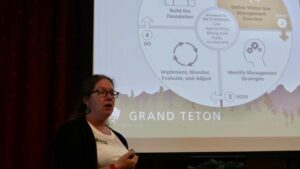
National Park Service Visitor Use Project Manager Rachel Collins talks about the steps of the Interagency Visitor Use Management Framework process. (Hannah Habermann / Wyoming Public Media)
After the presentations, people perused poster boards and chatted with staff one-on-one. Superintendent emphasized that roughly 85 percent of the Grand Teton’s visitors are day-users, which puts a heavy load on infrastructure like parking spaces.
“When you build 100 more hotel rooms somewhere within an easy drive of Jackson Hole, that means that there are 300 or 400 more people that are going to be on the landscape. We have no influence or control over those decisions in terms of where overnight accommodations are being built within 100, 120, 150 miles, so we have to respond to those changes happening in terms of having more people on the landscape,” he said.
Jenkins said they really want to hear people’s opinions, but he also wants people to provide concrete details about potential solutions.
“If you think that you want some sort of a reservation or a timed entry system, how does that look to you? Is it for a parking space at a different location? Is it for multiple different places?” he said.
Ernie Anderson has been in the Jackson area since the 1970s and lives on an inholding in Grand Teton National Park. He said some kind of reservation system, especially for the boat across Jenny Lake, could go a long way.

Grand Teton National Park social scientist Jenn Newton discusses changes in yearly recreation visits and overnight stays in the park. (Hannah Habermann / Wyoming Public Media)
“A lot of people come up there and want to take the boat concession across the lake, but they come there without a reservation. So now they have a two hour wait and in the meantime, all these vehicles are stacking up in the parking lot on the road and so on,” he said.
Anderson said those sorts of changes will likely take a while, but he’s hopeful that they will happen eventually.
“It’s public land, so we’ve got to try and accommodate the employees as well as the customers, the visitors coming in – trying to find a balance. And sometimes it takes a while for those wheels to turn,” he said.
The park will hold a virtual meeting on July 23rd to answer questions and bring in more public opinion about the planning process. The park is accepting public comment through August 12th, which can be submitted online through the National Park Service’s Planning, Environment and Public Comment website.
